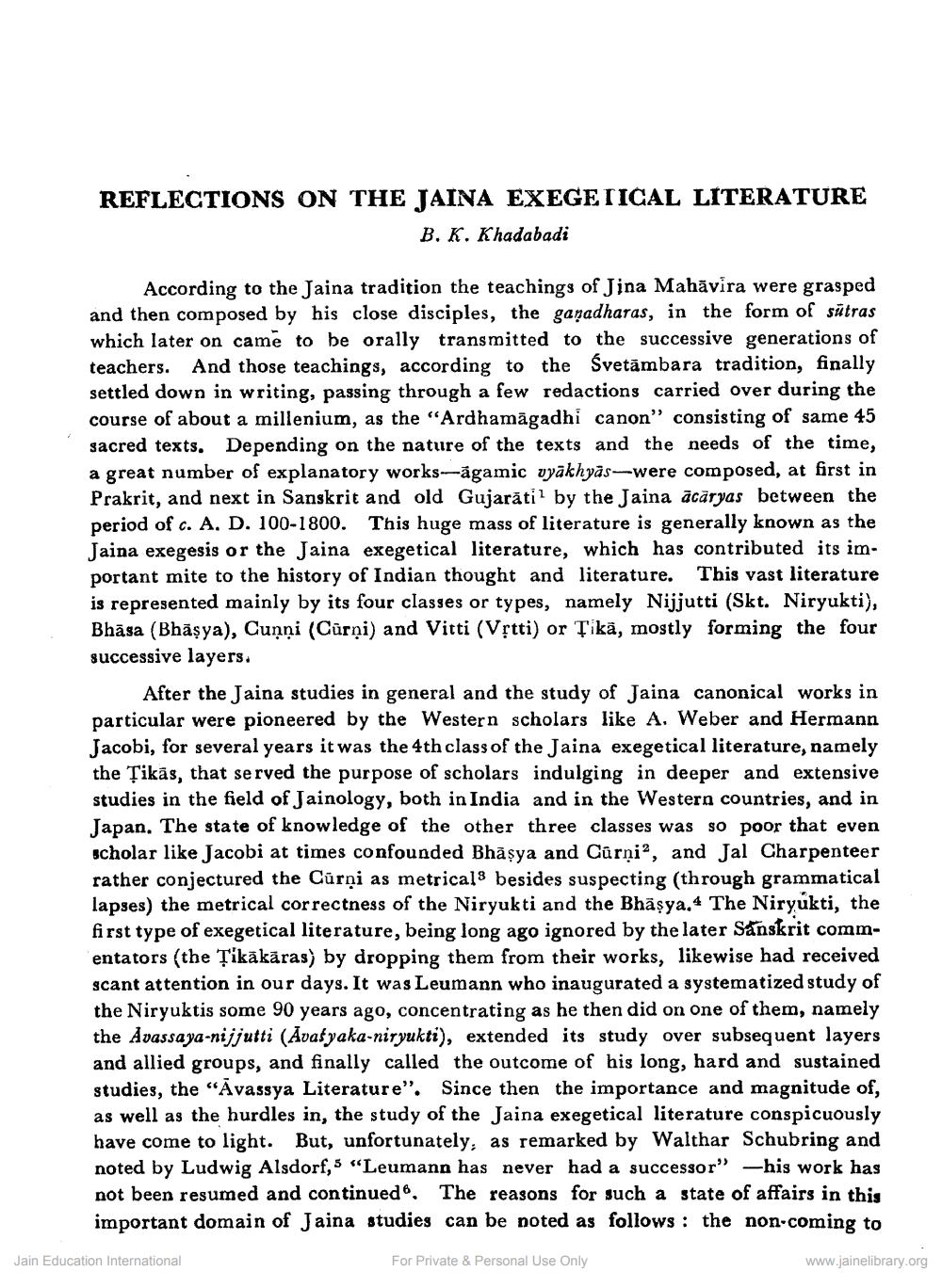Book Title: Reflections on the Jaina Exgetical Literature Author(s): B K Khadabadi Publisher: Z_Aspect_of_Jainology_Part_3_Pundit_Dalsukh_Malvaniya_012017.pdf View full book textPage 1
________________ REFLECTIONS ON THE JAINA EXEGETICAL LITERATURE B. K. Khadabadi According to the Jaina tradition the teachings of Jina Mahāvira were grasped and then composed by his close disciples, the gañadharas, in the form of sütras which later on came to be orally transmitted to the successive generations of teachers. And those teachings, according to the Svetāmbara tradition, finally settled down in writing, passing through a few redactions carried over during the course of about a millenium, as the “Ardhamāgadhi canon' consisting of same 45 sacred texts. Depending on the nature of the texts and the needs of the time, a great number of explanatory works-agamic vyakhyas--were composed, at first in Prakrit, and next in Sanskrit and old Gujarāti? by the Jaina ācāryas between the period of c. A. D. 100-1800. This huge mass of literature is generally known as the Jaina exegesis or the Jaina exegetical literature, which has contributed its important mite to the history of Indian thought and literature. This vast literature is represented mainly by its four classes or types, namely Nijjutti (Skt. Niryukti), Bhāsa (Bhāşya), Cunni (Curņi) and Vitti (Vștti) or Tika, mostly forming the four successive layers. After the Jaina studies in general and the study of Jaina canonical works in particular were pioneered by the Western scholars like A, Weber and Hermann Jacobi, for several years it was the 4th class of the Jaina exegetical literature, namely the Țikās, that served the purpose of scholars indulging in deeper and extensive studies in the field of Jainology, both in India and in the Western countries, and in Japan. The state of knowledge of the other three classes was so poor that even scholar like Jacobi at times confounded Bhāşya and Cũrņia, and Jal Charpenteer rather conjectured the Cūrņi as metricals besides suspecting (through grammatical lapses) the metrical correctness of the Niryukti and the Bhäşya. 4 The Niryukti, the first type of exegetical literature, being long ago ignored by the later Sanskrit commentators (the Țikākāras) by dropping them from their works, likewise had received scant attention in our days. It was Leumann who inaugurated a systematized study of the Niryuktis some 90 years ago, concentrating as he then did on one of them, namely the Avassaya-nijjutti (Avaš yaka-niryukti), extended its study over subsequent layers and allied groups, and finally called the outcome of his long, hard and sustained studies, the "Āvassya Literature". Since then the importance and magnitude of, as well as the hurdles in, the study of the Jaina exegetical literature conspicuously have come to light. But, unfortunately, as remarked by Walthar Schubring and noted by Ludwig Alsdorf, 5 “Leumann has never had a successor" -his work has not been resumed and continued. The reasons for such a state of affairs in this important domain of Jaina studies can be noted as follows: the non-coming to Jain Education International For Private & Personal Use Only www.jainelibrary.orgPage Navigation
1 2 3 4 5 6 7
